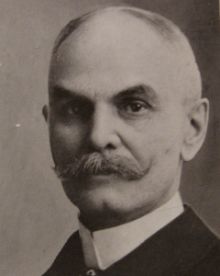 If you had to describe James H. Whiting in one word it would be distinguished. Outside of the Durant-Dort employee circle, few people had as much of an impact on Billy’s career as Mr. Whiting. Thirteen years Billy’s senior, Jim Whiting thought ahead like Billy, perhaps even more so, because not once, but twice, Whiting led the way for Billy and sold him the seeds, as it were, to his success.
If you had to describe James H. Whiting in one word it would be distinguished. Outside of the Durant-Dort employee circle, few people had as much of an impact on Billy’s career as Mr. Whiting. Thirteen years Billy’s senior, Jim Whiting thought ahead like Billy, perhaps even more so, because not once, but twice, Whiting led the way for Billy and sold him the seeds, as it were, to his success.
In Michigan’s early days lumber was the engine which drove the economy. In the fall of 2016 my wife’s cousin and I drove across Michigan’s Upper Peninsula (U.P.) as part of a 10,000 mile road trip. Miles and miles and miles of simple, untouched woodlands at their blazing color peak. For hours this is all we saw:

That made it easy to imagine the whole of Michigan covered in virgin swaths of birch and conifers. American entrepreneurs saw a different kind of beauty: fodder for their sawmills. Thus was born the Michigan lumber boom, creating millionaires like Henry Crapo (Billy’s GrandPa). By the early 1870s Flint had become a leader in the lumber industry, led by the mills of Henry Crapo and Begole, Fox & Company.
Enter Whiting
Whiting, born in Connecticut, moved to Flint to make money the Levi Strauss way: selling hardware to the lumber mills. Slow growing trees, of course, are no match for the devouring lumber mills and the forests vanished. Whiting, who had become friends with Charles Begole, persuaded his company to move into manufacturing. Following the lead of William A. Paterson, they decided on wagon making and thus was born the Flint Wagon Works.
Whiting was, by all accounts, a smart and upstanding businessman. Billy Durant and Dallas Dort started making low-end carts and buggies in 1886 and Whiting, though technically a competitor, was a friend and helped guide the young men.
Automobiles first gained traction in 1902, when Ransom Olds’ Curved Dash Oldsmobile became the first car to sell in any kind of volume. (A thousand cars per year in those days passed for radical volume.) Whiting, again, saw the future. Through a fortuitous connection (described in Comeback!) Whiting made the acquaintance of Benjamin Briscoe, who had a problem: he had not one, but two automobile ventures to choose from, and he wanted to sell one.
Whiting thus bought the controlling interest in David Buick’s struggling automobile venture. Smart man that he was, he spent his money solving the problem most aspiring automakers failed at: he took a concept and brought it to the point where it could be manufactured. Once Whiting was satisfied the Buick Model B was ready to support a real business, he turned his attention to the next problem: sales. He knew the perfect person to solve that problem: Billy Durant.
Whiting’s timing was perfect. Although Billy scoffed at the thing they called the horseless carriage, he was bored. Durant-Dort, his creation, was running itself. Led by Dallas Dort, his team of ABC Hardy, Charles Nash and Fred Aldrich took care of everything. Orders poured in by themselves and there was little more Billy could add. So he spent more and more of his time in New York, learning to play the stock market, which was to become his biggest interest later in life.
But most of all, Billy loved to create and sell. As Comeback! relates in colorful detail, Whiting brought the completed concept to Billy–all it needed was the selling. Which Billy did with aplomb and success: by 1907 Buick was the world’s top seller.
Round Two
Whiting made good money as a Buick stockholder but his main business, the Flint Wagon Works, was again left without an automobile to bet on when the inevitable happened and the horse-drawn vehicle business went the way of the lumber mills. So, after Billy got banished from his baby in 1910, and Nash purged GM of all Billy loyalists, Whiting and Begole hired Arthur Mason and began designing an automobile of his own called, you guessed it, the Whiting.
Whiting was good at running a business, but was not a salesman. He was also good at maintaining a good business network. Billy floundered around after he was cut loose from General Motors, and it was none other than Jim Whiting who put his arms around Billy, pretty much handed him the Whiting, and helped give him direction. With Mason, Begole, Whiting and Big Bill Little, another Nash purge victim they began pulling the loose ends together. When Louis Chevrolet left Billy in a huff, and puff of his Gauloises, Billy persuaded ABC Hardy to leave GM and head up the newly consolidated company, which took Chevrolet’s name.
Were it not for Jim Whiting, therefore, you could easily say Billy would never have taken Buick to a position of leadership in automobiles. General Motors would not have existed… and it is unlikely that Chevrolet would have amounted to anything strong enough to take over General Motors.
Jim Whiting, in many ways, therefore, was the man behind The Man. Today, a prominent entertainment complex in Flint carries his name to make sure nobody forgets.